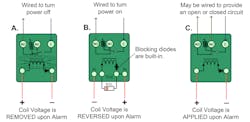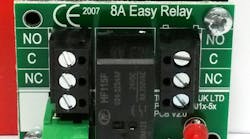Last column, I wrote about various applications where fire alarm relays could be used to integrate a commercial fire alarm system with other electrical systems at a customer’s site to provide them features which may cause your proposal to outshine a competitor’s (read it at www.securityinfowatch.com/12400925). To follow up, I will provide a more in-depth discussion of how those relays operate and why choosing the correct one to activate an emergency control function is so important.
When wiring or selecting a relay to perform an emergency safety function, there are a few questions you need to consider, that when answered, will bring the task into focus and enable the best choice to get the job done safely and reliably.
Rules for all relays
The relay’s load may be AC or DC, but must be within amperage rating of the relay contacts. The relays must be fire alarm listed and supplied by the FACP manufacturer, or be a Listed Fire Relay from a manufacturer such as “Air Products and Controls Inc.”
Off-the-shelf electrical supply relays are not permitted to be directly wired to a fire alarm system. Additionally, polarity must be observed because of the integrated diode used in the relay.
Testing of the fire alarm system includes only verifying the relay changed state, and not necessarily the operational performance of the fire-safety function itself. Proper fire alarm relay operation will be verified by using a meter or by observing an activation LED on the relay.
Question 1: Will your relay be used to supply electrical power or turn it off? You are not responsible for the connection and operation of any other trade’s equipment or function, but you cannot allow the relay to be used improperly. If your relay states it has contacts rated at 10 amps and the owner wishes to turn on 20 amps of outdoor lighting, then they will have to use your relay to switch another device having the proper load rating (i.e. 20 amps or less).
While it is true that the relay, wiring, contactor or equipment could fail without causing a trouble signal on the fire alarm system, you are only responsible for the relay and circuit that you provide up to the switched contacts of the relay. All equipment after your relay contacts is the responsibility of another trade or another contractor.
Question 2: Will your relay be used to switch a small current and low voltage signal used by another electrical system, rather than the safety equipment load? Sometimes the load you need to switch amounts to an electrical control signal of just 5V – which another system’s data input needs in order to perform a function. Since you must supply a relay that is used to perform a certain function, you are not responsible for performing everything the owner wants to do. For example, your relay cannot pulse an illuminated street address sign.
Question 3: Is the safety function to be performed a code-required fire alarm feature such as controlling elevators, or is it a customer nicety such as opening a driveway gate or turning on outdoor lighting? For a code compliant relay, its wiring must be either fail-safe or cause a Trouble Signal when power to the relay fails.
For Illustrated Relay A
Power to certain emergency safety functions may need to be turned off during an alarm. Examples of these functions commonly include power to electro-magnetic door holders or electro-magnetic door locks. These two examples are normally well within the electrical rating of a fire relay, but a contactor may also be needed if you intend to cut power to a club’s DJ booth, for example, that is providing amplified sound, light and stage effects. If a contactor/relay is also needed, the electrician will supply it.
Relay A rules: Common and Normally Open relay contacts are used to supply a CLOSED circuit to keep safety equipment operational.
This relay’s wiring is “Fail-Safe,” since loss of power to the relay coil will cause the fire-safety function to be performed. No EOL resistor or power supervision relay is required if the emergency function is performed when loss of power to the relay causes the safety function to be performed.
For Relay B
Power to safety functions may need to be turned on during an alarm. This may include smoke exhaust fans and indoor/outdoor lighting. Typically, a 10 amp relay will be used to switch an additional contactor/relay that would be needed for a large rooftop fan, for example.
Relay B rules: Common and Normally Open relay contacts are used to supply a CLOSED circuit to deactivate safety equipment upon a polarity reversal signal from the FACP upon alarm conditions.
This relay wiring is NOT “Fail-Safe,” since loss of power to the relay will not cause the fire-safety function to be performed. Instead, this wiring method will cause a FACP trouble signal should there be a fault on the wiring supplying power to the relay.
A circuit fault or any other loss of power to operate the life safety function may need to be supervised. For example, supervision of the electrical power to operate the elevator’s shunt controller is required to ensure the 110vac power to perform the emergency shunt trip is constantly present. The modern self-contained elevator shunt-trip panels contain a set of relay contacts that will close should the shunt-trip lose its operational power for any reason. Wire a dedicated IDC with an EOL resistor across these provided open terminals. Any loss of that 110vac operating power will cause their relay contacts to close and initiate a Supervisory signal. This signal must be specifically and descriptively annunciated (ie “elevator shunt-trip power loss”).
For Relay C
Use only for non-life safety applications or as allowed by the exception (see below).
Relay C rules: Common and Normally Closed and/or Normally Open Relay contacts may be used to activate or to deactivate customer’s equipment. This Relay is NOT “Fail-Safe,” since loss of power to the relay will not cause the fire-safety function to be performed. Also, power wiring to the relay coil can experience a fault without causing a FACP Trouble signal.
An exception allows this relay’s wiring configuration to be used to perform code-required safety functions. This is when a relay output within a control unit is used to activate a function performed by another control unit. This happens when an FACP on-board relay is used to close a set of input contacts of another control panel. For example, you can trip a NAC power booster using the alarm output relay of the main control panel. This exception allows a relay circuit to connect two control units even though the relay wiring is neither monitored for integrity nor provides fail-safe operation.
This wiring exception is only permitted if both control units are located in the same room, the control units are within 20 feet of each other, and the relay wiring connecting both panels is protected against mechanical injury by running it either inside the wall or on the surface using conduit.
Bonus: Elevators
An elevator company provides a shunt-trip panel whenever the machine room or hoist way includes sprinklers. This panel ensures the elevators will be shut down before sprinkler water can reach sensitive electrical and mechanical components. Your job will be to provide a fail-safe relay (example A) or power-supervised relay (example B), and contacts that will close upon an alarm signal from the hoist way or elevator equipment room detectors.
Greg Kessinger has been SD&I’s fire alarm and codes expert and a regular contributor for more than 15 years. Please email him your fire & life safety questions for potential inclusion in this column at [email protected].



